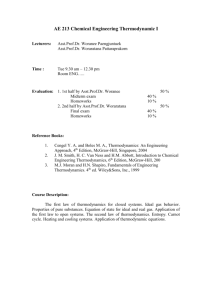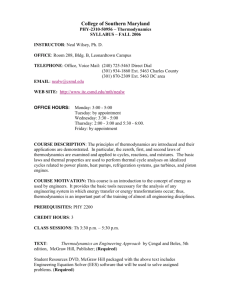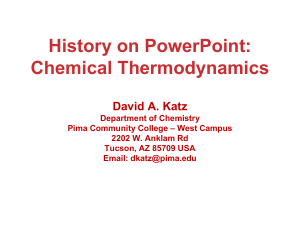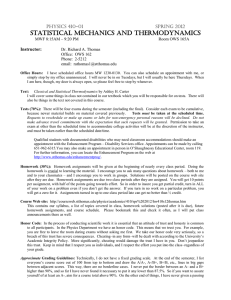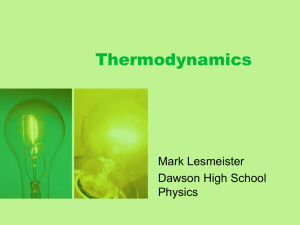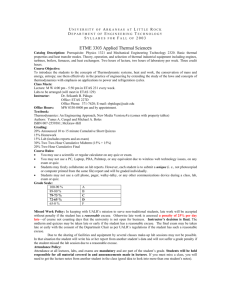ME 435 Thermodynamics Text- Cengel & Boles Thermodynamics- An... 7 Ed & Property Table Booklet-for 7
advertisement
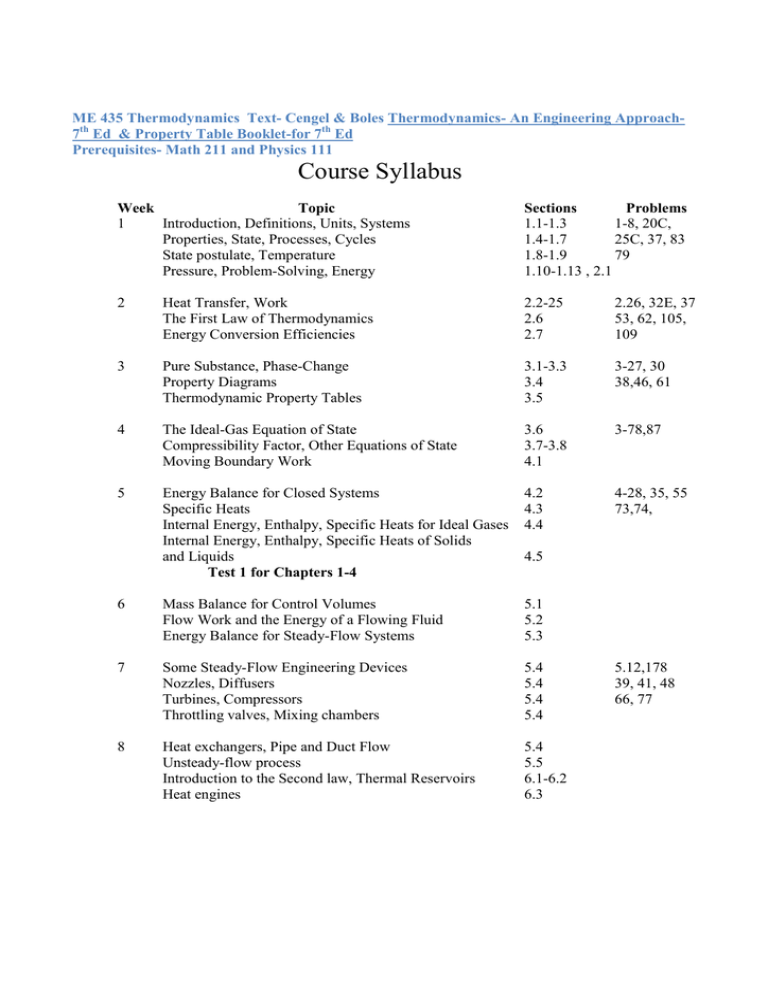
ME 435 Thermodynamics Text- Cengel & Boles Thermodynamics- An Engineering Approach7th Ed & Property Table Booklet-for 7th Ed Prerequisites- Math 211 and Physics 111 Course Syllabus Week Topic 1 Introduction, Definitions, Units, Systems Properties, State, Processes, Cycles State postulate, Temperature Pressure, Problem-Solving, Energy Sections Problems 1.1-1.3 1-8, 20C, 1.4-1.7 25C, 37, 83 1.8-1.9 79 1.10-1.13 , 2.1 2 Heat Transfer, Work The First Law of Thermodynamics Energy Conversion Efficiencies 2.2-25 2.6 2.7 2.26, 32E, 37 53, 62, 105, 109 3 Pure Substance, Phase-Change Property Diagrams Thermodynamic Property Tables 3.1-3.3 3.4 3.5 3-27, 30 38,46, 61 4 The Ideal-Gas Equation of State Compressibility Factor, Other Equations of State Moving Boundary Work 3.6 3.7-3.8 4.1 3-78,87 5 Energy Balance for Closed Systems Specific Heats Internal Energy, Enthalpy, Specific Heats for Ideal Gases Internal Energy, Enthalpy, Specific Heats of Solids and Liquids Test 1 for Chapters 1-4 4.2 4.3 4.4 4-28, 35, 55 73,74, 4.5 6 Mass Balance for Control Volumes Flow Work and the Energy of a Flowing Fluid Energy Balance for Steady-Flow Systems 5.1 5.2 5.3 7 Some Steady-Flow Engineering Devices Nozzles, Diffusers Turbines, Compressors Throttling valves, Mixing chambers 5.4 5.4 5.4 5.4 8 Heat exchangers, Pipe and Duct Flow Unsteady-flow process Introduction to the Second law, Thermal Reservoirs Heat engines 5.4 5.5 6.1-6.2 6.3 5.12,178 39, 41, 48 66, 77 Week 9 Topic Sections Refrigerators, Heat Pumps, Perpetual-Motion Machines 6.4-6.5 Reversible & Irreversible Processes, Carnot cycle 6.6-6.7 Carnot Principles, The Thermodynamic Temperature Scale 6.8-6.9 Problems 6.18,57 10 Carnot Heat Engine Carnot Refrigerator and Heat Pump Entropy The Increase of Entropy Principle Test 2 for Chapters 4 –7.2 6.10 6.11 7.1 7.2 11 Entropy Change of Pure Substance, Isentropic Processes Property Diagrams Involving Entropy, What Is Entropy T ds Relations, Entropy Change of Liquids and Solids 7.3-7.4 7.5-6.6 7.7-7.8 12 Entropy change of Ideal Gases Reversible Steady-Flow Work, Compressor work Isentropic Efficiencies of Steady-Flow Devices Entropy Balance 7.9 7.10-7.11 7.12 7.13 13 Mixture Dry air and Water Wapor - Specific Humidity Dew Point Temperature –Wet Bulb Temperature Pyschrometic Chart and Air Conditioning Processes 14.1-14.3 14.3-14.4 14.4- 14.7 To Be Assigned Cycles- Rankine Cycle Brayton Cycle Otto and Diesel Cycles 10.2 9.8 9.5-9.6 To Be Assigned 14 6.22, 94 103 7-7C, 39, 48 52, 132, 82 67, 125, 146 156 Course Grading Information. –. Section ME 435001-2010- Tests-closed textbook,. One sheet of non-xerox notes equations only , no solutions or partial solutions, no additional aids. Calculator required. No cell phones. No sharing allowed. a. Tests – 20% ; Grade for any missed test will be recorded as a grade of zero .. b. * Short quiz based on lectures and assigned homework problems – Semester total-10%, No Make-up. It is expected that the reading assignment will be complete prior to discussing material in class. Any “Homework” specifically due is due at the beginning of class and in the format specified. On a rotating basis, HW problems will be placed on the board. -10% c. Class participation – Semester total-5%- you are expected to sign the attendance sheet at each class. d. Final Exam - 35 % Comprehensive e. The NJIT Integrity Conduct Code will be strictly enforced . Any violations will be reported to the Dean of Students. f. Work copied or the use of unauthorized aid will not be accepted or graded . Cell phones must be turned off during class. Use of laptops or any communication device during class or during a test (quiz) is prohibited. Reserve right to modify as necessary. Assignment Sheet also available at: web.njit.edu/~florio/FLORIO.htm Course Motivation: This course is an introduction to the concept of energy. It provides the basic tools necessary for the analysis of any engineering system in which energy transfer or energy transformations occur; thus, thermodynamics is an important part of the training of almost all engineering disciplines. Homework Homework is an important part of this course. You are expected to have solved every assigned problem. Homework problems will be placed on the board on a rotating basis by permanently assigned homework groups. Questions on the homework problems should be brought up then. Quizzes- There will be periodic quizzes covering assigned problems and lecture material . Any missed quiz is recorded as a grade of zero. Tests. Generally 3-4 problems which are similar to the HW, Short quizzes or class problems. Attendance: You are expected to attend all classes and to sign the daily attendance sheet. Specific Course Objectives: The students will be asked to demonstrate their knowledge of the material covered in this first thermodynamics course through their mastery of the following course objectives. Through the study of this material the student will be able to: 1. Determine properties of real substances, such as steam and refrigerant 134-a, and ideal gases from either tabular data or equations of state. • Use absolute, gage, and vacuum pressures correctly. • Calculate gage and vacuum pressures using the manometer equation. • Use absolute and Celsius temperatures correctly. • Determine property data using the steam and R-134a tables. • Sketch P-v, T-v, and P-T plots for steam, R-134a, and ideal gases. • Locate data states on P-v, T-v, and P-T plots for steam, R-134a, and ideal gases. • Determine the condition of a data state as a compressed, saturated, or superheated state and determine the thermodynamic properties at that state by using property tables. • Demonstrate the use of quality in finding properties of two-phase substances. • Apply the concept of the generalized compressibility factor to demonstrate when the ideal gas equation may be used to determine the state of a gas. • Apply the ideal gas equation to solve problems involving pressure, temperature, and volume of ideal gases. • Determine changes in internal energy and enthalpy for ideal gases. • Determine mass flow rate from its definition and relation to volume flow rate. 2. Analyze processes involving ideal gases and real substances as working fluids in both closed systems and open systems or control volumes to determine process diagrams, apply the first law of thermodynamics to perform energy balances, and determine heat and work transfers. • Determine the pressure-volume relation for processes and plot the processes on P-v and diagrams. • Calculate the boundary work for a variety of processes for closed systems. • Apply the first law to closed systems containing ideal gases, steam, or R-134a to determine heat transfer, work, or property changes during processes. • Apply the first law to steady-flow open systems containing ideal gases, steam, and refrigerant134a to determine heat transfer, work, and property changes during processes. 3. Analyze systems and control volumes through the application of the second law. • Determine the efficiency of heat engines and compare with the Carnot heat engine efficiency. • • Determine the coefficient of performance of refrigerators and heat pumps and compare with refrigerators and heat pumps operating on the reversed Carnot cycle. • Determine entropy changes for both ideal gases and real substances. • Plot processes on both P-v and T-s diagrams. • • Determine the properties of a working fluid at the end of an isentropic process. Apply both the first and second laws to determine heat transfer, work, and property changes during processes occurring in both closed and open systems. 4. Analyze systems Air Conditioning processes through the application of the laws of thermodynamics 5. Analyze common cycles- Rankine, Brayton, Otto and Diesel using the basic principles of thermodynamics.
